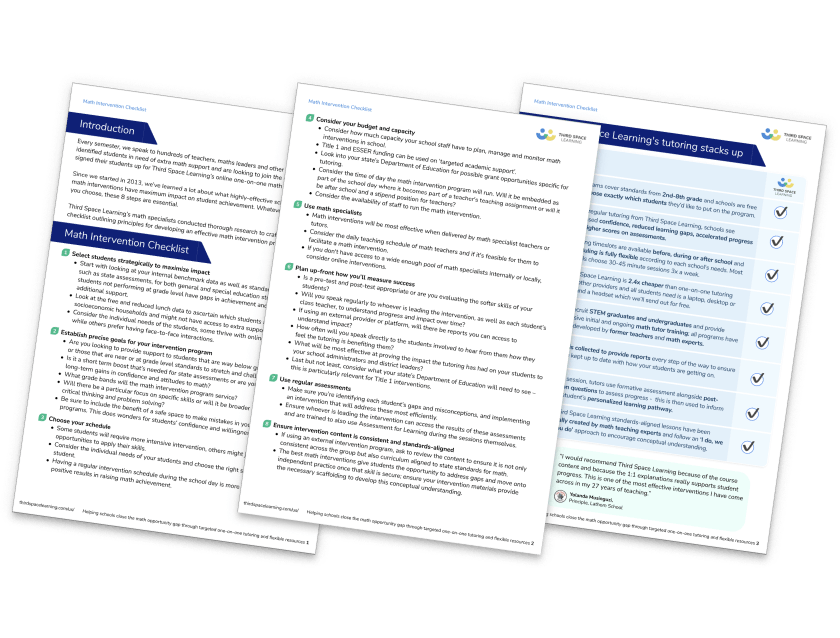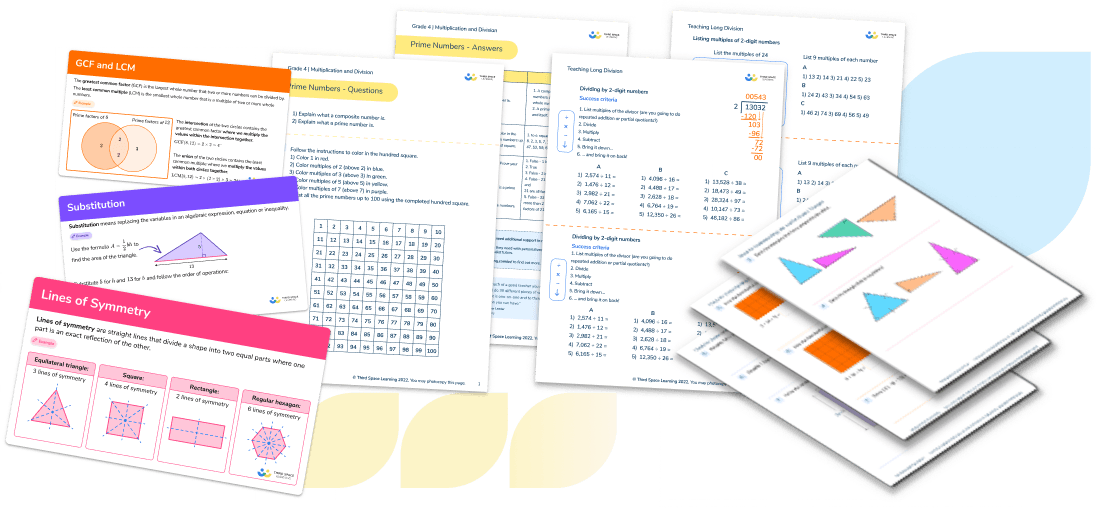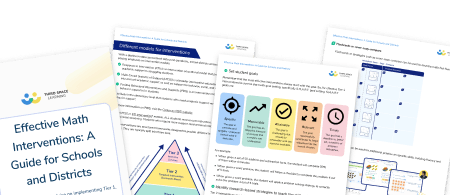What Is Math Intervention? A Comprehensive Guide To What It Is And 7 Best Math Intervention Practices
Not all students find math easy, some will need a math intervention or extra math program to keep up. Whether this extra support is provided by math interventionists in school or class teachers, this guide will help you support students improve their math skills through explicit instruction and other effective strategies.
If you’re not a specialist math interventionist, it can be overwhelming knowing where to start when implementing math interventions for students.
Many math intervention myths add to this overwhelm. This article will help to debunk these myths and provide a deeper understanding of math interventions. Discover practical tips and guidance to help you implement successful interventions from elementary through to high school.
What is math intervention?
A math intervention is a targeted instructional approach to math. It is designed to provide additional support and assistance to students who struggle with math skills and concepts. Identifying students who need support is crucial for tailoring effective interventions based on assessment data.
In short, high impact tutoring and math interventions help students who are behind in their math learning and may need support from MTSS or RTI. This specialized form of education aims to identify and address specific challenges that individuals face in understanding and applying math.
Intensive intervention is a critical component of RTI strategies, providing a structured approach to enhance math skills for those who struggle.
Math intervention programs are implemented to help:
Close learning gaps
Secure math skills
Promote a deeper comprehension of mathematical concepts
Effective Math Interventions: A Guide for School Leaders
Everything you need to know about implementing effective tiered math interventions, with free resources and research-based strategies for use in the classroom
Download Free Now!What is the goal of math intervention for student progress?
Schools and districts use math intervention to:
Address gaps in grade-level knowledge
Boost math progress
Promote math proficiency
Math intervention aims to support student growth in mathematics by providing targeted strategies that enhance student performance over time.
The goals and personalization of Math interventions should be based on the students receiving the instruction.
By using personalized and differentiated instruction for reteaching math strategies, educators can:
Help students progress in math
Build confidence
Develop mathematical skills
Students who struggle with math can often dislike and disengage from lessons. Extra math support provides the opportunity to build on math skills and develop a love of math.
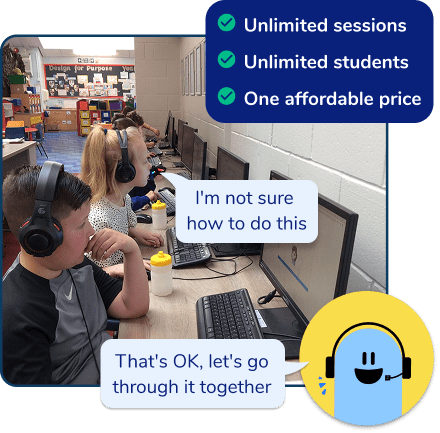
Meet Skye, the voice-based AI tutor making math success possible for every student.
Built by teachers and math experts, Skye uses the same pedagogy, curriculum and lesson structure as our traditional tutoring.
But, with more flexibility and a low cost, schools can scale online math tutoring to support every student who needs it.
Find out moreWhat is a child-friendly definition of math intervention?
Grade K students may not understand what a math intervention is or why they need one. If extra math programs take place away from the classroom, having a child-friendly definition of math interventions to explain what is happening can help.
Math intervention is like having a special helper – either a teacher or a tool – that gives you extra support and cool tricks to make learning math easier and more fun.
Who needs a math intervention?
When students encounter difficulties that hinder their math progress, it’s time to implement a math intervention.
Struggling learners often need additional support to overcome these challenges and improve their mathematical understanding.
Students may face challenges in math when there are:
Diverse learning styles
A lack of number sense
Gaps in prior knowledge
Difficulties in grasping abstract math concepts such as fractions
Difficulties in understanding key math concepts
When challenges are identified early on, math intervention programs can begin as early as grade k and elementary school. Tutoring for math interventions can take place during the school year or as a summer tutoring program
Tailor each math intervention to the unique needs of individual students and use a range of instructional strategies, resources, and formative assessment tools to facilitate targeted learning.
Other children who could need a math intervention include:
Struggling students
Students with learning difficulties
English Language Learners (ELL)
Struggling students
Individuals who experience math anxiety can have difficulty grasping fundamental mathematical concepts. If they struggle with basic arithmetic skills, they may benefit from a math intervention.
Equally, students who consistently perform below grade level in mathematics or are identified as two grade levels or more behind may require math interventions. Assessment of grade level standards can be essential in identifying these students.
When students reach middle school, these performance gaps tend to become more obvious. Diagnostic assessments throughout elementary are essential for early Response To Intervention.
Students with learning differences
Specific learning disabilities can negatively impact mathematical processing. Additional needs such as dyscalculia can affect a student’s numeracy and mathematical comprehension.
Indicators like these highlight students who may need an additional math program outside of whole class instruction to improve fact fluency and confidence.
Those with learning difficulties but are not identified as requiring special education are often ideal candidates for mathematics intervention.
English Language Learners (ELLs)
Children with English as a second language will often benefit from a math intervention. An extra math program could help ELLs overcome language barriers within the math curriculum such as:
Key math terminology
Understanding word problems.
Developing math proficiency
Problem-solving
Using graphic organizers and visual math facts for each math topic can be particularly helpful in accelerating math progress for ELL students.
Research-based math intervention programs
Every math intervention program a school or district implements needs to be well-researched. Interventions must be evidence-based and prove they positively impact a student’s mathematical outcomes.
Often, these programs focus on individualized instruction, differentiation, and targeted support.
Response to intervention (RTI) is an example of a research-based intervention program that bridges the gap between the general education classroom and mathematics intervention through early intervention.
RTI is a tiered system of support, with increasing levels of intensity based on individual student needs:
Tier 1 — whole group strategies in the general classroom
Tier 2 — specialized small group instruction
Tier 3 — targeted individualized instruction
Response to intervention emphasizes the use of data-driven decision-making to monitor student progress and adjust interventions as needed.
You can implement all three tiers across all grade levels, including elementary, middle, and high school.
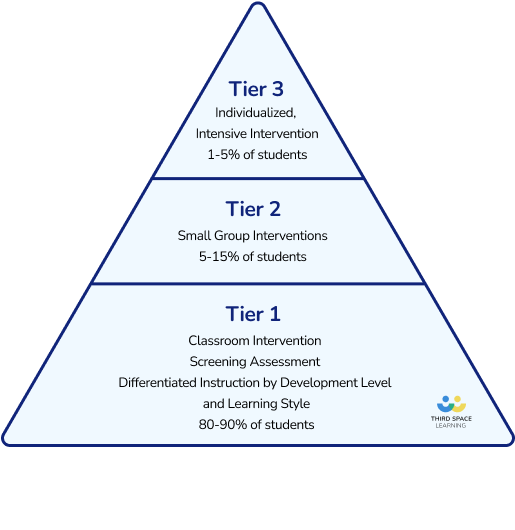
Math intervention strategies
Successful math interventions use evidence-based strategies to improve students’ mathematical abilities.
Teaching students with tailored instruction to meet their individual needs is crucial for effective math intervention.
A range of evidence-based math intervention strategies are available for math teachers to support students’ progress. Some examples of math intervention strategies used in schools include.
Diagnostic assessments help to identify gaps in knowledge.
Regular testing assesses the success of the intervention
Hands-on activities and manipulatives
Visual resources to improve conceptual understanding
Small group work for individualized instruction
Math intervention: 7 best practices
Implementing an intervention won’t automatically boost student progress. But there are certain practices that contribute towards implementing successful interventions.
Here are 7 best practices to ensure your math interventions are effective:
1. Early intervention
Often, it can be tempting to hope students will catch up and leave interventions until middle school or high school.
The earlier math difficulties are detected and the response to intervention begins, the better. Start math intervention in elementary school to help students avoid larger difficulties with math later on.
For example, you have a 3rd grade student who struggles with basic multiplication facts. Rather than waiting until they encounter more complex math, simply implement daily 10-minute sessions using a multiplication grid where the student fills in products, starting with 2’s and 5’s tables, gradually progressing to harder ones. This prevents difficulty when they need multiplication for later concepts like area or fractions.
You can use these 18 free math intervention resources to get you started.
2. Diagnostic assessment
Diagnostic assessments are a helpful tool to identify struggling students and the appropriate math interventions that need to be put in place.
Based on diagnostic assessment results, students might require personalized math intervention. This additional math program should cater to the math strands they need help with most.
Ongoing student assessments are a helpful form of progress monitoring. They ensure the math interventions are working for students as well as identifying areas for further support, they highlight areas of improvement
3. Tiered support
Tiered interventions are a crucial component of a multi-tiered system of supports (MTSS) or response to intervention (RTI) framework. This approach provides a structured and systematic way to deliver math interventions to students who require additional support.
The tiered system consists of three levels of support:
- Tier 1
- Tier 2
- Tier 3
4. Engaging instruction
Often, students disengage with instruction if they struggle with the topic. Making lessons engaging can help boost student progress. Using technology, manipulatives, visuals and hands-on activities can help to promote student engagement.
The Concrete-Representational-Abstract progression enables learners to build a conceptual understanding of the mathematical skills they struggle with.
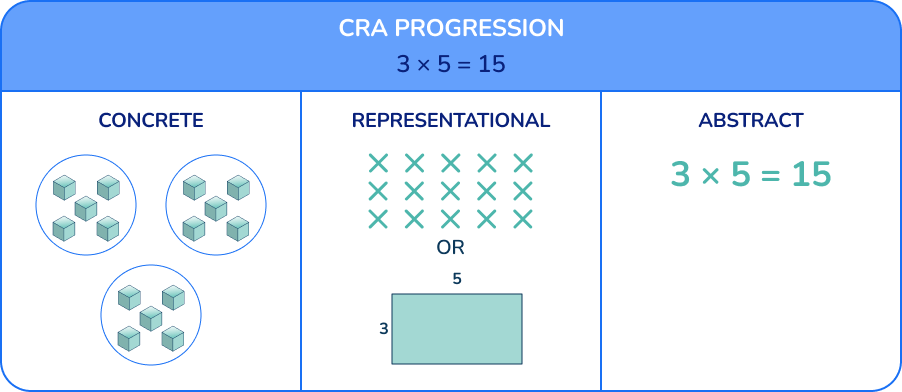
Providing students with meaningful, personalized math instruction breaks down more complex concepts to help students grasp a better understanding of the topics they struggle with.
Students better relate to math tutoring when it is personalized to real-life situations and engages the learning.
For example, a group of students are struggling with area and perimeter and need an intervention. You could create engaging instruction by teaching area and perimeter through a “Design a Dream Bedroom” project with tiered stages:
- Abstract: Calculate the area and perimeter using formulas
- Concrete: Students use tiles to create different room layouts
- Representational: Draw their designs on grid paper
Third Space Learning’s one-on-one math tutoring is personalized for each student. Ongoing assessments from highly qualified math specialist AI tutor Skye allows personalized instruction in real time.
Personalized one-on-one math instruction means students focus on the math topics they struggle with most, helping to accelerate math growth. An independent study found that students attending Third Space Learning’s personalized tutoring sessions made 7 months’ progress in just 14 sessions.
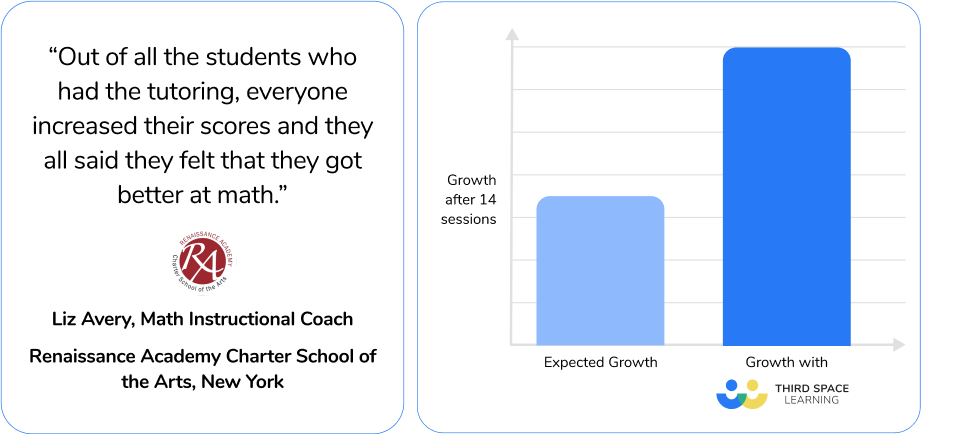
5. Evidence-based interventions
Ensure you use evidence-based strategies when implementing math interventions. Don’t waste time on approaches that may or may not work.
Using interventions backed by data to show student progress increases the likelihood of your students making progress too.
6. One-on-one
While small group math interventions allows instruction to be personalized to a group of students’ specific needs, they cannot cater for each individual. Math interventions are more effective when carried out one-on-one.
This way, instruction can be personalized to each student and they can receive instant feedback on work. If learners wait for feedback in a small group or whole class setting, it can lose context and meaning.
At Third Space Learning, every math intervention session takes place one-on-one to ensure our highly trained AI tutor can adapt teaching and learning to best meet each student’s needs.
When sessions are one-on-one, Skye can support the student to close individual learning gaps and improve their math achievement.
Because sessions take place online, you can support up to 20 students at once with a highly trained math specialist tutor.
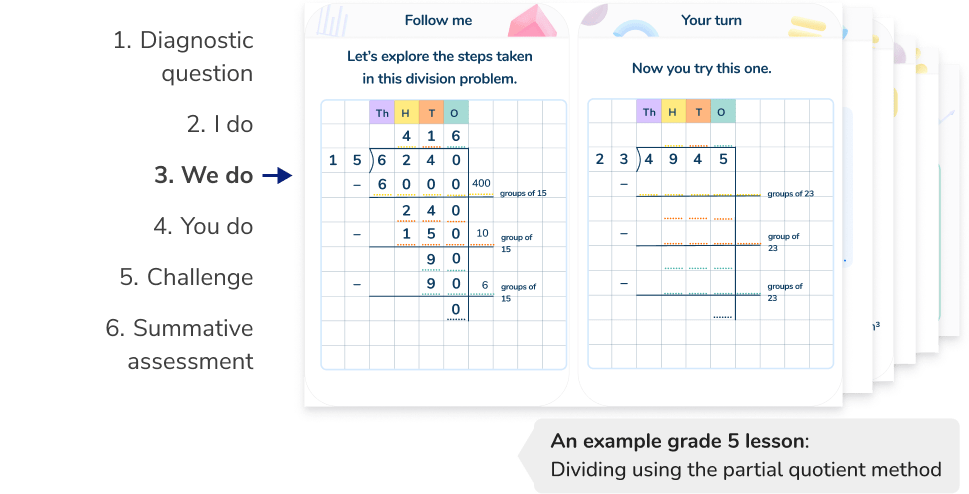
7. Involve parents
Keeping parents and carers informed and involved with interventions helps support math outside the classroom. For example, give parents weekly “Math at Home” activities. For instance, students are learning decimal operations, ask parents to encourage their children to compare product prices (like $2.99 vs $3.50), calculate the difference, and estimate total costs while grocery shopping. This reinforces decimal addition and subtraction in real-world contexts.
Parental involvement, such as the example above, can contribute towards a positive learning environment and boost math progress.
How can Third Space Learning support math interventions?
Third Space Learning provides one-on-one math tuition for the students who need it most.
No one knows your students like a teacher does so schools decide which standards each student needs additional practice with each week.
Each one-on-one math lesson is designed to close learning gaps and address misconceptions through high-quality math tutoring from Skye.
Ongoing diagnostic assessment identifies areas students need to work on, and highlights the progress they have made.
After each session, teachers receive a detailed report for each student, showing topics covered, skills practiced and progress made.
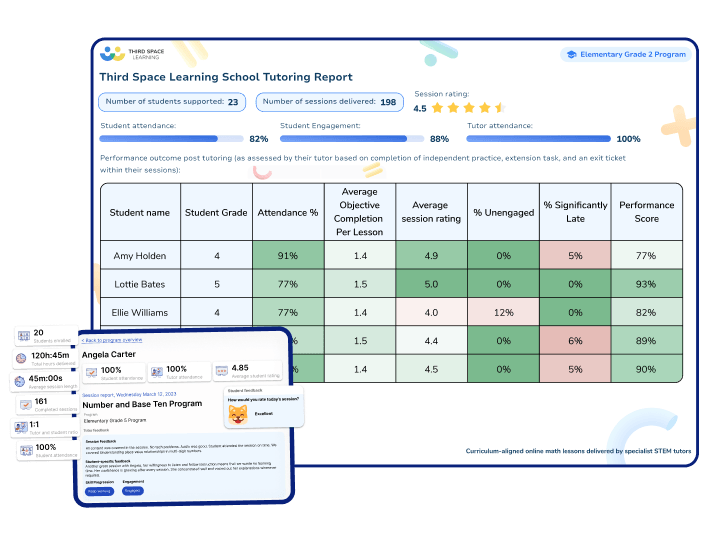
FAQs
Here are 5 examples of intervention strategies:
1. Diagnostic assessments: Identify specific areas of mathematical difficulty for each student, allowing for targeted intervention addressing individual needs.
2. Individualized instruction: Tailor interventions based on diagnostic assessments, addressing specific learning styles, strengths, and weaknesses to promote a more effective and targeted learning experience.
3. Progress monitoring: Regularly monitor and assess students’ progress to gauge the effectiveness of interventions, make adjustments and celebrate small successes to boost confidence and motivation.
4. Small group instruction: Implement small group instruction to facilitate personalized interactions, immediate feedback, and a collaborative learning environment.
5. Technology integration: Utilize educational technology to engage students, provide additional practice opportunities, and adapt interventions to individual needs.
Evidence-based math intervention strategies draw on research-supported methods to address learning challenges effectively. These strategies often include diagnostic assessments to identify specific areas of difficulty, allowing for targeted interventions. Individualized instruction, progress monitoring, and the integration of technology are common features, providing personalized support, continuous assessment, and engaging tools for a more comprehensive and impactful learning experience.
1. Diagnostic assessments play a pivotal role by thoroughly identifying specific areas of difficulty for each student. These assessments serve as a starting point for targeted interventions, addressing individual needs effectively.
2. Individualize instruction, tailoring interventions with personalized plans based on diagnostic assessments. This recognizes and addresses diverse learning styles, strengths, and weaknesses to create a more impactful and personalized learning experience.
3. Progress monitoring, regular assessments allow educators to gauge students’ progress, make timely adjustments, and celebrate small successes, ultimately boosting confidence and motivation. By combining these three approaches, math intervention seeks to provide comprehensive and tailored support, fostering a positive and successful mathematical journey for every student.
Do you have students who need extra support in math?
Skye—our AI math tutor built by experienced teachers—provides students with personalized one-on-one, spoken instruction that helps them master concepts, close skill gaps, and gain confidence.
Since 2013, we’ve delivered over 2 million hours of math lessons to more than 170,000 students, guiding them toward higher math achievement.
Discover how our AI math tutoring can boost student success, or see how our math programs can support your school’s goals:
– 3rd grade tutoring
– 4th grade tutoring
– 5th grade tutoring
– 6th grade tutoring
– 7th grade tutoring
– 8th grade tutoring
